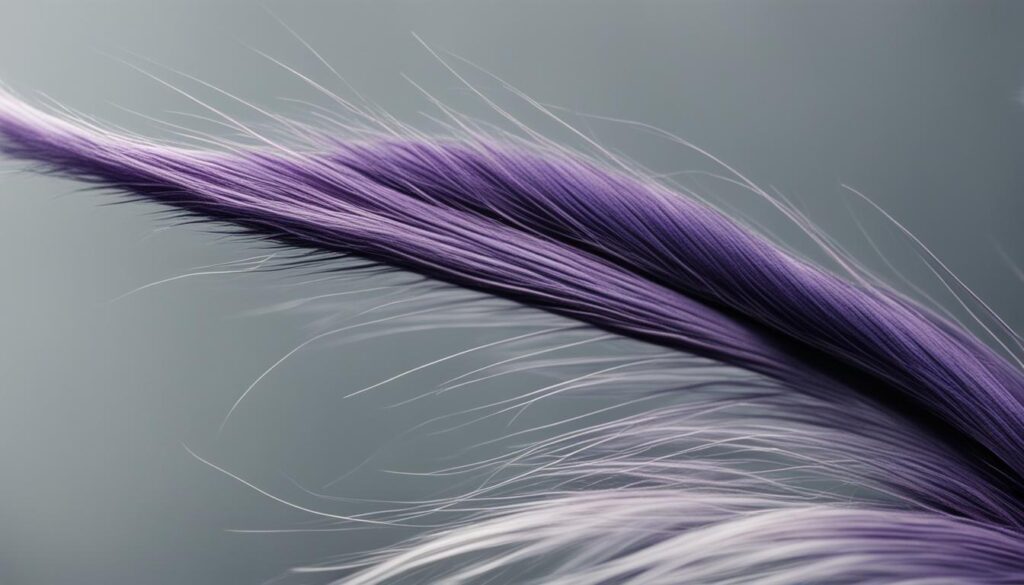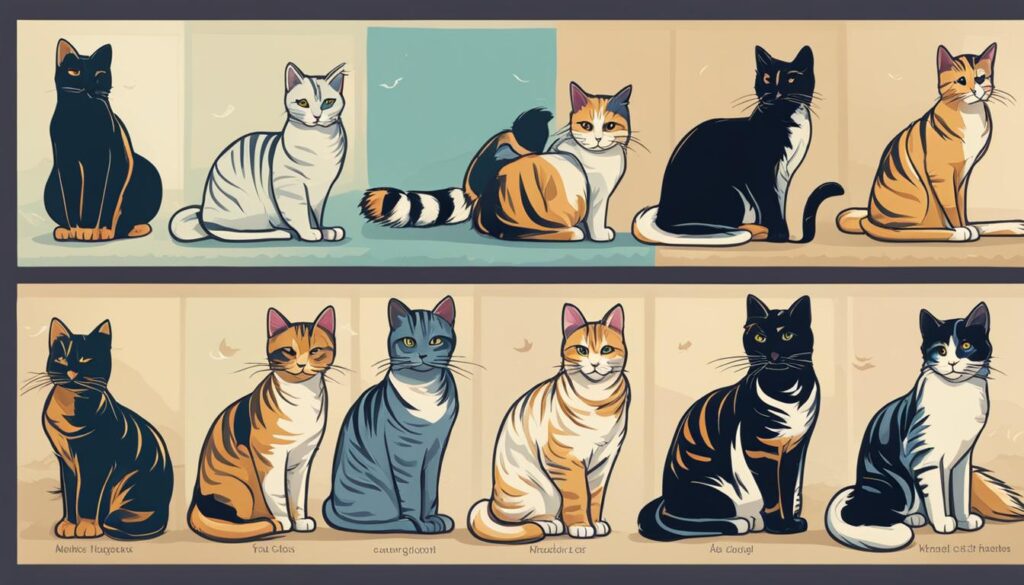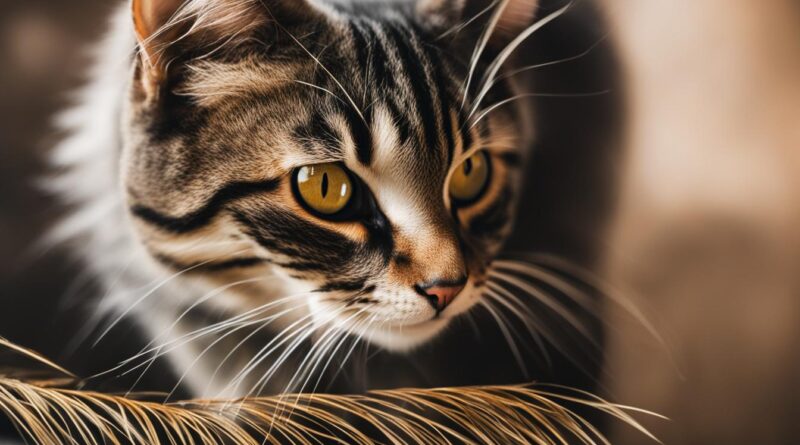Why Does My Cat’s Tail Vibrate? Answers Revealed
Have you ever wondered why your cat’s tail vibrates? It’s a curious behavior that leaves many cat owners puzzled. Understanding why cats’ tails vibrate is essential to deciphering their emotions and communication habits.
Cat experts explain that a wagging or vibrating tail is a form of feline communication, conveying various messages. Just like humans use body language and facial expressions, cats utilize their tails to express themselves. Tail movements can indicate excitement, uncertainty, displeasure, or even pain.
By recognizing the nuances of different tail positions and movements, cat owners can develop a better relationship with their feline companions. So, let’s delve into the fascinating world of cat tail vibration and unravel its secrets.
Key Takeaways:
- The vibrating tail is a form of feline communication.
- Tail movements convey various messages, including excitement, uncertainty, displeasure, or pain.
- Understanding cat tail language can help strengthen the bond between cat owners and their feline companions.
- Observing the position, speed, and context of tail movements is crucial in interpreting a cat’s emotions and intentions.
- Decoding cat tail movements promotes a healthier and happier relationship with these enigmatic and beloved animals.
Decoding Cat Tail Movements: What They Really Mean
Cat tail movements are a crucial aspect of feline communication and can provide valuable insights into a cat’s mood and intentions. By understanding the different positions and movements of a cat’s tail, cat owners can better interpret their furry friend’s emotions and respond accordingly.
When it comes to cat body language, tail position plays a vital role. A high and upright tail signifies confidence and a friendly greeting, indicating that your cat is feeling calm and at ease. On the other hand, a curved tail, often seen when a cat is approaching or engaging in play, demonstrates happiness and readiness for interaction.
“A high and upright tail signifies confidence and a friendly greeting, while a curved tail indicates happiness and readiness to play.”
Conversely, a low or tucked tail can indicate nervousness or fear. When a cat tucks its tail close to its body, it may be a sign that it is feeling anxious or threatened. Similarly, a puffed-up tail suggests aggression or intense fear, as your cat tries to appear larger and more intimidating to a potential threat.
Another significant tail movement to be aware of is rapid tail wagging. This can convey excitement or agitation, depending on the context. If your cat’s tail is wagging rapidly while playing, it is likely expressing enthusiasm and enjoyment. However, if the tail is rapidly wagging in other situations, it may indicate heightened emotions or discomfort.
“A low or tucked tail can indicate nervousness or fear. Conversely, a puffed-up tail suggests aggression or intense fear.”
Understanding these different cat tail movements is essential for cat owners to effectively interpret their cat’s needs and emotions. By observing and recognizing these body language cues, you can foster a stronger bond with your feline companion and provide them with the care and attention they require.
Cat Tail Movements at a Glance
| Tail Position | Meaning |
|---|---|
| High and upright | Confidence and friendly greeting |
| Curved | Happiness and readiness to play |
| Low or tucked | Nervousness or fear |
| Puffed-up | Aggression or intense fear |
| Rapid wagging | Excitement or agitation |
Tail Vibrations and Emotional States
Tail vibrations, or the shaking of a cat’s tail, can reveal their emotional state. A deliberate swishing of the tail may indicate that a cat is focused and ready to pounce on its prey. Rapid swishing without any pouncing or playing activities may suggest that the cat is perturbed and needs some alone time.
A puffy and flared upright tail can be a sign of fear or anger, while an upright tail with a hook shape at the end indicates a happy and peaceful state. A low and tucked tail suggests nervousness, while a horizontal tail parallel to the floor suggests uncertainty.
By observing these tail movements, cat owners can better understand their cat’s emotions and respond accordingly.
Feline Emotions and Tail Vibrations
Understanding cat emotions can be challenging, but tail vibrations offer valuable clues. Cats communicate primarily through body language, and their tails play a significant role in expressing their emotional states.
“Cat experts explain that a wagging or vibrating tail is a form of feline communication, conveying various messages.”
Whether it’s a slight tremor or a vigorous shake, tail vibrations can indicate a range of emotions. Recognizing and interpreting these subtle cues can help cat owners foster a deeper understanding and connection with their feline companions.
Decoding Cat Tail Movements
Each tail movement carries its own meaning, providing insights into a cat’s emotional state. To assist cat owners in understanding their feline friends better, the table below summarizes common tail vibrations and their associated emotions:
| Tail Movement | Emotion |
|---|---|
| Deliberate swishing | Focused/preparing to pounce |
| Rapid swishing | Perturbed/needs alone time |
| Puffy and flared upright tail | Fear or anger |
| Upright tail with hook shape | Happy and peaceful |
| Low and tucked tail | Nervousness |
| Horizontal tail parallel to the floor | Uncertainty |
By learning to decode these tail movements, cat owners can better respond to their cats’ emotional needs, creating a more harmonious and loving environment.

Tail Movements and Communication While Purring
While tail movement alone may not fully reveal a cat’s mood, it can provide additional cues when combined with other body language. If a cat wags its tail while purring, it may be a sign of self-soothing or contentment. However, the context is crucial. If the cat wags its tail while playing or stalking, it likely signals excitement and engagement with the activity. Different noises accompanying the tail wagging can also help interpret the cat’s behavior. Growling and tense tail wagging indicate anger and annoyance, while lying down and snoozing with a wagging tail suggests relaxation. Curling around legs and purring with a tail wag can indicate contentment. Understanding the connection between tail movements and purring can enhance the bond between cat and owner.
Purring, along with tail movements, is a form of communication that cats utilize to express their emotions and needs. It is a common belief that cats purr when they are happy. However, cats may also purr when they are stressed, anxious, or experiencing pain. Therefore, it’s essential to consider the entirety of the cat’s behavior rather than relying solely on purring or tail wagging to gauge their emotional state.
Rapid Tail Wagging and Emotional State
The speed of a cat’s tail wagging can provide insights into their emotional state. The quicker the tail flicks back and forth, the more likely the cat is on edge or put off in some way. A fully and rapidly wagging tail may indicate the cat is about to attack prey or another cat, signaling a state of excitement. Conversely, slow and low swishing may indicate slight annoyance, while low tail flicking back and forth signals unhappiness and a readiness to defend itself. Rapid swishing motion generally suggests a happy, playful, and mentally stimulated cat. Paired with other behavioral cues like pinned ears, a tense body, and growling, rapid tail movement can indicate anger, annoyance, or distress.
Key Points:
- The speed of a cat’s tail wagging is indicative of its emotional state.
- A fully and rapidly wagging tail signifies excitement or readiness to attack.
- Slow and low swishing indicates slight annoyance.
- Rapid swishing generally suggests a happy and mentally stimulated cat.
The speed at which a cat wags its tail is a form of non-verbal communication. By paying attention to the speed and intensity of the tail movements, cat owners can gain valuable insights into their feline companion’s emotional well-being. The faster the tail flicks back and forth, the more engaged and stimulated the cat is, whether it be in play, hunting, or defending itself. Conversely, slow and low swishing can indicate a mild form of annoyance or unhappiness. Understanding these tail movements can help cat owners respond appropriately and provide a conducive environment for their cat’s emotional needs.
Cat Tail Movements During Sleep
Cats are known for their unique behaviors, and this includes their tail movements during sleep. Just like humans, cats may experience involuntary responses while they are asleep. These movements can involve twitching of the tail muscles, feet, and even lips. While the exact reason for these movements is not fully understood, it is believed that cats may be dreaming during these episodes.
Observing your cat’s tail movements during sleep can offer fascinating insights into their dream world and the scenarios they experience when awake. It’s intriguing to think about what goes on in a cat’s mind as they twitch their tails while sleeping. Do they dream about chasing mice or birds? Do they envision themselves climbing tall trees or exploring new environments? Unfortunately, we can’t fully understand or decode their dreams, but it’s fun to speculate.
However, it’s important to note that not all tail movements during sleep are necessarily related to dreaming. Cats may also move their tails in response to external stimuli without fully acknowledging them. For example, if there’s a sudden noise or movement in their environment, their tail may twitch as an involuntary reflex.
Although scientists have yet to fully uncover why cats exhibit tail movements during sleep, it’s clear that it is a natural occurrence for these curious and fascinating animals.
Different Tail Movements and their Meanings
Cat tail movements encompass a variety of gestures, each with its own meaning. Understanding these tail movements is key to decoding cat behavior communication and deciphering their intentions and emotions. Here are some common tail gestures that can provide insight into your feline companion’s state of mind:
| Tail Position | Meaning |
|---|---|
| High Tail in the Air | Signifies confidence and a friendly greeting |
| Curved Tail | Indicates happiness and readiness to play |
| Low Tail | Suggests uncertainty or unease |
| Tucked Tail | Signifies fear or submission |
| Puffed-Up Tail | Expresses alarm or an attempt to intimidate |
| Rapidly Whipping Tail | Conveys agitation or excitement |
| Swishing Tail Movements | Demonstrate focus or can be a precursor to agitation |
By observing these tail movements, cat owners can gain a better understanding of their cat’s intentions and emotions, allowing for enhanced communication and a deeper bond between feline and human.

Interpreting Tail Movements and Body Language
It’s important to note that tail movements should be considered in conjunction with other body language cues to accurately interpret a cat’s behavior. Pinned ears, body posture, facial expressions, and vocalizations can provide further context and help discern the full range of a cat’s emotional state. Paying attention to these subtle signals can foster a stronger connection and ensure a harmonious relationship with your feline companion.
Conclusion
Understanding your cat’s tail movements is crucial for comprehending their behavior and emotions. By carefully observing the position, speed, and context of their tail movements, you can unlock valuable insights into their communication cues. Whether it’s a wagging tail during playtime or a twitching tail during sleep, each movement carries significance and can help strengthen the bond between you and your feline companion.
Decoding cat tail language promotes a healthier and happier relationship with these enigmatic and beloved animals. By paying attention to their tail communication, you can better understand their needs, desires, and emotional states. This understanding allows you to respond appropriately, ensuring your cat feels understood, safe, and loved.
So, the next time your cat flicks their tail or waves it in the air, take a moment to interpret their message. By charmingly deciphering their tail movements, you’ll deepen the connection with your cat, unraveling the hidden language of their wagging tails and enhancing your understanding of their fascinating feline behavior.
FAQ
Why does my cat’s tail vibrate?
Cat tail vibration is a form of feline communication. It can convey various messages, such as excitement, uncertainty, displeasure, or even pain.
What do cat tail movements indicate?
The position and movement of a cat’s tail can reveal its emotions and intentions. Different tail positions can signify confidence, happiness, nervousness, fear, aggression, or excitement.
What does tail shaking in cats mean?
Tail vibrations or shaking can reveal a cat’s emotional state. It can indicate focus, perturbance, fear, anger, or happiness depending on the context and shape of the tail.
How does tail movement relate to cat purring?
Tail movement combined with purring can indicate a cat’s contentment or engagement in an activity. However, the context is important, as tail wagging during playing or stalking may signify excitement and interaction.
What does rapid tail wagging in cats signify?
The speed of a cat’s tail wagging can provide insights into their emotional state. Rapid wagging may indicate excitement, while slow swishing may signal annoyance or unhappiness.
Why do cats exhibit tail movements during sleep?
Cats may move their tails during sleep, and it may indicate some level of dreaming. These involuntary movements can reveal their dream experiences and scenarios.
What are the different meanings of cat tail movements?
Cat tail movements can convey a variety of gestures and meanings. High and upright tails signify confidence, curved tails indicate happiness, low or tucked tails suggest uncertainty or fear, puffed-up tails express alarm or intimidation, and rapidly whipping tails can indicate agitation or excitement.
How important is understanding cat tail movements?
Decoding cat tail movements is crucial in understanding their behavior and emotions. It helps cat owners interpret their communication cues effectively and strengthens the bond between cats and their human companions.


